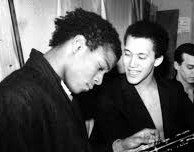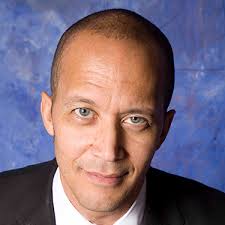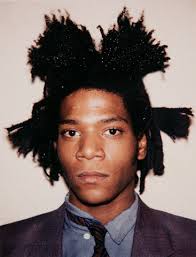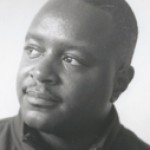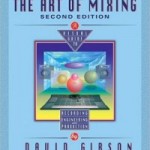Michael Holman on Jean Michel Basquiat!
Michael Holman is a filmmaker, screenwriter, journalist, avante-garde musician and Hip-Hop impresario. Michael has helped to connect the uptown Hip-Hop world to the downtown art world. The connection of these worlds has contributed to the world wide Hip-Hop explosion we see today. As you will see in the interview below Michael Holman was at the very forefront of the Hip-Hop movement in 1979 as a creative visionary, master networker, true believer in the viability and long term success of the Hip-Hop culture. On the other side of his cultural coin he was deeply steeped in the downtown art scene. Michael was a contemporary, bandmate and close friend of the iconic painter Jean Michel Basquiat. They both started the avant-garde musical band Gray. They both soaked up and absorbed the early 80’s downtown scene and were able to carve out and grow into their individual niches. Michael Holman is very well known as the screenwriter of the Miramax film “Basquiat”. I have recently interviewed Michael Holman on his creative life and his friendship with Jean Michel Basquiat. Within this interview we will learn about some of the unique inner characteristics of Jean Michel Basquiat. Special Thanks to Renowned Pencil Artist Lee Tompkins for making me aware of Jean Michel Basquiat several years ago. Enjoy!
Q: What inspired you to learn and focus on the arts, music and filmmaking?
A: I have always been an artist. I have always been as a young kid, I was an artist and had artistic interests. I did a lot of painting and drawing. I was always that kid in elementary school who was either the best drawer, or was in a competition with the guy or gal who was the best artist. That was always me. I could draw wolves and horses better than anyone else. I think a lot of people start that way in elementary school. Can you draw a particular animal or creature better than anyone else. It impresses the other kids. You start to realize “hey”, I’m pretty good at this. That was me. I always had a desire to paint, to express myself with oil paint. I always wrote stories. I always thought in terms of stories. I think that led to me wanting to make films later in life. I am kind of a polymath in that I like to express myself in every medium I feel like. A lot of kids got piano lessons, and I did too. I never was any good at anything I was being taught. I would find ways to take what I was being taught by, piano teachers, or guitar teachers to kind of go in my own direction, and kind of try to deconstruct the instrument, deconstruct the idea of music. Later in life when I met Jean, we created the band Gray. It was natural that I would approach, we all would in the band approach music from a real ignorant point of view. Not really understanding music from a musical, polished, classic musical point of view. We would approach it from a more experimental style. Part of the rules of being in the band Gray was that you couldn’t actually know how to play something. If you did, we did not want you in the band. We would approach the music from something other than a classic point of view and by doing that you would be creating something new and different that hasn’t been done before.
Q: What was the inspiration behind the show Graffiti Rock?
A: I had already been involved in Hip-Hop for a number of years. I got involved in Hip-Hop as early as 1979. I met Fab 5 Freddy and he turned me on to it. We did not call it Hip-Hop, we were artists in the game. I was shooting a lot of B-Boy’s, DJ’s and filming them with a Super 8 camera. I was just trying to get some gigs, being an impresario, create situations where this art form could be shown or just demonstrated in front of audiences. Early on, from 79′ on I was involved in presenting what would become Hip Hop art, a multifaceted movement in front of audiences downtown and got involved heavily in a club called Negril associated with Ruza Blue. She asked me to bring my Hip-Hop review to perform there, which I did. She wanted to expand the idea to the Roxy. I wanted to take it to television. I already had a cable television show in 82′ and was using that as a platform to show a lot of the videos in Super 8 I had been shooting within the Hip-Hop culture presenting and broadcasting it on cable television, in New York at the time. At the time it was a very small audience. It wasn’t as big as cable is today. I had a couple of shows on cable television as early as 1982. By 1983 or so, when Ruza Blue was bringing Hip Hop to the Roxy, I was thinking I want go even bigger. I want to bring this to television. I started out with Cable TV, and then found some investors who were willing to support my dream and help me build the show, then I could hopefully make a pilot out of it, and air it across the country on syndicated television, then bring it to NAPTE which is the National Association of Producers of Television Entertainment. It is a convention that happens every year in Las Vegas. I would hopefully sell the pilot to enough stations to have a series. I did all of those things except for the very last thing, which was to convince the station managers around the country to buy the show. They thought that what Graffiti Rock was really no different than Soul Train. They thought Rap was a passing fad. I was just too far ahead of my time.
Q: How many music videos have you filmed? How was it filming RUN DMC’s Christmas In Hollis?
A: It was really exciting. I Produced and Directed that video. It was great because I had a lot of fun directing RUN DMC and being involved with Def Jam. I got all kinds of interesting people to be involved with it. It had a great story. DMC’s mother was in the video. I played off of a Dr. Seuss, Grinch stole Christmas kind of motif. I got my friend Michael Cotten to do the production design. He had been doing production design for Michael Jackson and artists like that. It was special because the song was part of a Special Olympics Christmas album that was put together by one of the Kennedy’s kids. Sargent Shriver and Eunice Shrivers son. I got to meet the Kennedy’s through doing the video. When the music video got played it ended up winning Rolling Stone’s Magazine video of the year award. Then it showed for every Christmas for years and years. It may be one of the most played music videos. I am really proud of that. I also did another video for a rapper in Houston named Raheim. He was part of the Geto Boys Group. I made Doug E Fresh’s first video: All The Way To Heaven. I did a commercial for Adidas for RUN DMC. It aired across the country.
Q: How was it for you to be involved in the creation of the movie Beat Street?
A: I was the Associate Producer on that. I helped bring the different talents to the film. I brought Rock Steady Crew to that. I introduced Treacherous 3 to the movie. I actually directed the battle scene in the film between Rock Steady Crew and New York City Breakers. I did special effects and wrote some of the scenes. I was heavily involved in that film.
Q: How do you feel about the state of Hip-Hop today and the State of Music?
A: I feel Hip Hop today is really just Rap. I still see Hip-Hop as a multifaceted movement that includes dance, song, art, music, and language and all of those things. I think that perhaps the rap game is a little stale and what could give it new life, would be to let the idea of Hip-Hop Culture come back. It would be to bring the rappers, dj’s, dancers, graffiti artists to come back together again. Another possibility would be involving Rap more with the Avant-Garde. I kind of come from 2 different worlds. The Hip-Hop world as well as the downtown art world, which was like my band Gray with Jean. We are now working with Rich Nice from the Wrecking Crew on the new album. Gray’s 2nd album. It is going to have Hip-Hop influences as well as Avant-Garde noise and art sounds.
Q: I remember hearing you talking about Jean Michel Basquiat and saying that you have never met anyone with a personal magnetism or vibe like his. Could you expound on this?
A: I have known a lot of famous and important people through out my life and continue to meet interesting people, but I never met anyone like him. The best way I can explain it is like, he seemed to be or have the aura or have the magnetism of what some spiritual people call a Realized Being. Like the Dalai Lama. Somebody who has something that is somehow more than human. That somehow has a cosmic, spiritual, presence that seems something different than human, more elevated, more brilliant, more interesting. Jean was supersensitive. So sensitive that bad art, bad ideas would offend and hurt him in a way that blows would hurt someone else. This puts him in a rarified air. You could navigate the world of art, culture, just about anything, writing poetry, film, through his eyes you could see the power of art in a way that no one else could ever show. He was kind of interesting in that way. He was just so sensitive, yet he also had a powerful presence. He was also a very confident person. He knew his greatness. He knew that what he was doing was beautiful, and was powerful and would be influential. He knew he would be famous. That knowledge not on the level of conceit, but a level of awareness. That made him different than other people. Most people struggle with their own confidence with what they are about. Even the most successful artists wonder about their own merit. He never questioned his merit. He never questioned his brilliance. That made him special.
Q: You have mentioned that his intelligence was not expressed properly through the film Basquiat. Could you speak on his intelligence level. You could see it all through his painting and the different subject matters that were covered in them.
A: He seemed to have an intelligence that was beyond his experience, beyond his education, beyond his young years. He seemed to have an intelligence and sophistication that would have been much more likely in a 100 year old man who had lived around the world. Jean seemed to have that.
Q: Were there any other unique qualities of Jean that stick out to you, that people might not be aware of?
A: He had a great sense of humor and was very funny. You don’t see that much in some of the interviews. He was funny in a very intellectual way. His sense of humor was clever.
Q: What was your friendship like? Any memories?
A: We were good friends for a while. He had a funny way of collecting friends and discarding them. He did not keep his people close to him through his life. He never kept anyone close for very long. That is true of everybody. I remember we would talk about dating and girlfriends. Going out to the Mudd Club and partying. The band Gray was a special thing between us. That was something that he and I built and put together. When he eventually realized that he was going to become a really important artist and he didn’t really have time to be in the band. He pulled me aside and told me he had to leave the band. He did not say that in front of everyone. He only told me that. In a way it was a real honor that he did that.
Q: Did the movie Basquiat measure up to what you thought it could be? You wrote the screenplay to that film.
A: No it didn’t. It really didn’t. Jeffrey Wright was the perfect actor to play Jean, but how the script ended up. It didn’t capture Jean. The way he was directed did not capture who Jean was. That was unfortunate.
Q: How did you feel about the documentary: The Radiant Child?
A: The Radiant Child actually has Jean in it. You could actually see Jean. That was a much better document to capture who Jean really was. The greatest document that really captures who Jean was. It was this book called: Widow Basquiat. It is by Jennifer Clement. If people want to know who Jean was. That is a really good book to pick up.
Q: I am aware that you have a Kick Starter campaign for the Graffiti Rock Documentary? Tell the people about that.
A: We are in the middle of shooting the documentary. We are still trying to raise funds. If anyone wants to help contribute, they can just send whatever they want to contribute to the project vis a’ vis my Pay Pal account at: michaelholman101@hotmailcom
Special Thanks to Michael Holman for sharing his time and this valuable information with us.
Christie’s Auction for the Basquiat Painting: Dust Heads
Michael Holman Breaks Down Hip Hop History
Category: Entertainment News

